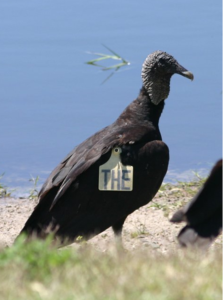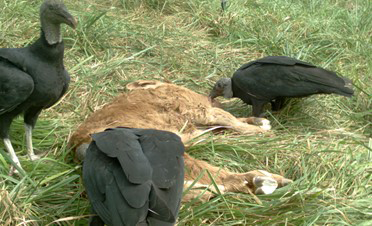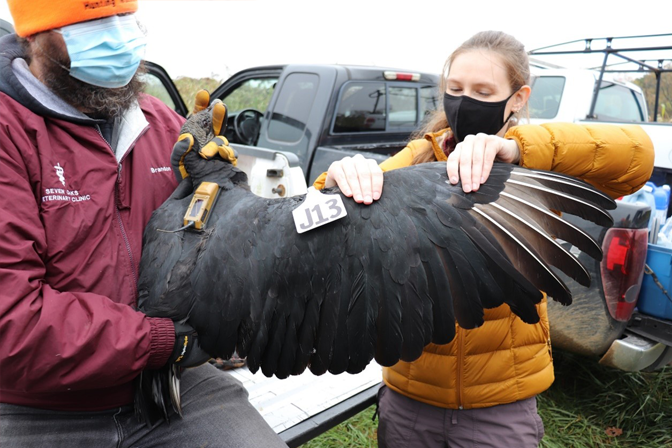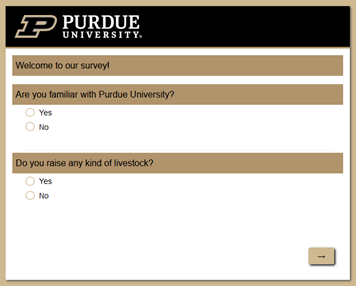Vultures play a critical role in the environment, cleaning up carcasses and acting as nature’s garbagemen. However, black vultures (Cathartes aura) are unique among New World vultures in that they are reported to kill vulnerable and newborn livestock, creating a financial burden to producers. Estimates suggest that black vulture depredation results in the losses of thousands to tens of thousands of cattle in the US annually.
Historically, black vultures were endemic to the southeastern United States and Central and South America. In the 1990s, black vulture distributions began expanding into unoccupied regions, including the Midwest of the US. As black vulture populations have grown, reports of depredation events increased. Livestock producers in the Midwest are increasingly concerned about impacts on their herds as vultures and depredation events become more common. This dynamic creates conflict between livestock producers and vultures. This project focuses on better understanding vulture ecology and the dynamics of the conflict in order to identify effective and defensible pathways to protect both livestock and birds.

Livestock necropsy work
We are creating a list of criteria that farmers can use to prove that they lost an animal to black vultures. To do this, we are working with the Animal Disease Diagnostic Laboratory at the Southern Purdue Agricultural center, conducting necropsies on livestock killed by vultures and livestock scavenged by vultures. By comparing these groups we will create a practical tool for livestock producers to prove when they’ve lost animals. This proof should help producers who are filling indemnity claims and seeking permits. To support this research we are collecting livestock that has been killed by vultures from farmers in Indiana and northern Kentucky.
If you lose an animal, please contact Marian Wahl at (317) 647-5294, and we can set up a time to pick up the animal at no cost. Please take pictures of the animal as soon as possible, including a full body shot, close ups of the head and anus, and any obvious wounds. If necessary, move the carcass somewhere where it will be difficult for scavengers to access until we can pick it up.

Better understanding producer experiences
While it’s clear that black vultures kill some livestock, the frequency at which that happens and the scope of the damage suffered by producers in in the Midwest is poorly understood. In early 2021, we will be surveying farmers to learn more about their experiences with vultures, livestock losses, and the effectiveness of different strategies to control conflicts with black vultures.
Producers responses to this survey will help us build a clear and complete picture of livestock losses here in the Midwest.
GPS tracking and mitigation
If we want to understand and manage the risk of livestock depredation, we need to know where birds are located, where they are foraging, and what factors on the landscape drive movements and behaviors. To do this, we are fitting vultures with tiny GPS “backpacks” that allow us to remotely monitor their movements. The data from these devices will enable us to delineate habitat types and characteristics that black vultures avoid or prefer. We will accomplish that by analyzing how much time they spend in different locations as well as how fast and straight vultures they move over different land cover types. This data will help identify landscape characteristics that may increase or decrease risk of human-vulture conflicts.
Ultimately, our plan is to use these transmitters to test how vultures react to strategies aimed at deterring them from bothering livestock. Such strategies include approaches such as deploying effigies of dead vultures near a pasture or using tools such as lasers to disperse roosts. The results of those experiments will help us determine whether these strategies decrease the threat posed by vultures or simply result in moving the birds a mile or two down the road.

Benefits of vultures
Despite the common perception that vultures have no value, they actually provide a vital ecosystem service as scavengers by cleaning the environment of carrion. Carcasses not scavenged by vultures decompose slower and attract mammalian carnivores such as coyotes. Increases in populations of other scavengers may pose a greater threat to livestock and can cause other undesirable effects. For example, when vulture populations declined dramatically on the Indian subcontinent there were drastic increases in rat and feral dog populations. As a consequence of those increases in rat and dog populations the rates of diseases that threaten human health, such as rabies and anthrax went up dramatically. So we all stand to gain from learning how vulture populations can coexist harmoniously with livestock production.
News
JWM: Vulture predation on cattle increases in Midwest, The Wildlife Society
Citizen Participation Needed in Black Vulture Research, Purdue University Forestry and Natural Resources
Researchers hope to mitigate black vulture predator problem, The News-Enterprise
Diet of Black and Turkey Vultures in a Forested Landscape, JSTOR
Black vultures moving north, extending into Vermillion County, Tribune-Star
Black Vultures Are Causing Problems On Farms, Purdue Needs Help Researching Them, Indiana Public Media
Improving understanding of black vulture depredation of calves in Indiana, AgSeed
As Black Vultures Expand Into Indiana, Farmers And Researchers Work To Understand Their Impact, WBAA.org
Beef Monthly, March 2021, Purdue Extension
Purdue/AEF Black Vulture Zoom, American Eagle Foundation
Resources
USDA Livestock Indemnity Program (LIP). The USDA Livestock Indemnity Program provides farmers with compensation for livestock lost to a variety of sources, ranging from severe weather events to losses by protected species like black vultures.
USDA Black vulture page. The USDA APHIS Wildlife damage management website. Provides information on vulture biology and different techniques used to manage black vultures
Indiana Wildlife Services. USDA APHIS Wildlife Services helps resolve conflicts between animals and people, working with citizens, companies, and government agencies.
Project Contact
Marian Wahl
wahlm@purdue.edu


